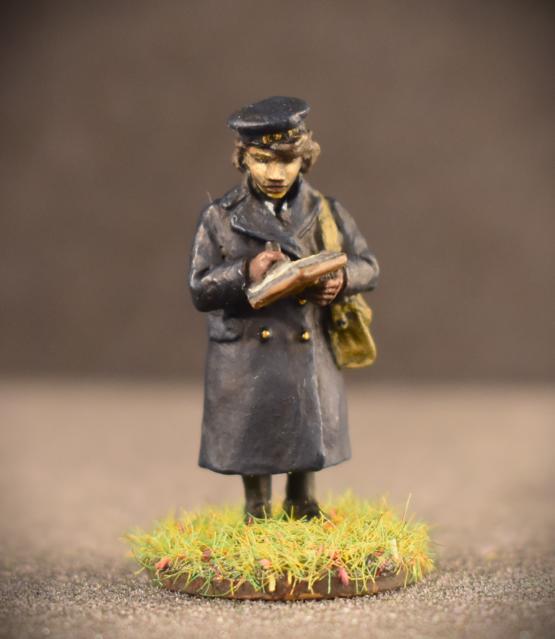My contribution to mark #FEMbruary 2022 is ready!
I’ve had fun painting these Naval ladies, featuring a great topic and nice sculpting as usual from Bad Squiddo. A Wren signaller like these in the Royal Navy during WWII would be expected to master the Aldis Lamp, the Semaphore and signal flags and, of course, Morse code. These five Wrens from the Second World War have been assigned the following signalling duties.
Message taking / transcription #1
I gave this lady a pair of leather gloves. I don’t know why. She looked like her fingers could get perishing cold taking down those messages received via Aldis Lamp or on semaphore flags.





The task of recording signalled messages was vital. The qualities required were:
“Neat handwriting, accurate spelling, good mnemonics and integrity. All were key attributes when it came to selection for The Communications Branch. Good handwriting meant messages were relaid accurately. Spelling went hand in hand with this. The ability to memorise lots of information was crucial and integrity was key due to the sensitive nature of the information communicated.”
Aldis Lamp operator



For the Aldis Lamp’s bright light, I added a large dollop of gloss varnish to create something of a glow. The Aldis Lamp was a means of communication using the flashing of a light beam to imitate Morse Code to the observer. The lamp’s design was named after Arthur Cyril Webb Aldis who patented a small hand-held version of the signal lamps previously used and which featured an improved shutter to better direct the beam to the recipient and away from the prying eyes of enemy U-boats.
Signal lamps are still in use today even it seems, on rare occasions, the venerable old Aldis Lamp. Yachting Monthly reported back in 2017 of a National Coastwatch Institute (NCI) watchkeeper averting a possible yacht grounding off The Lizard in Cornwall by using an old Aldis Lamp kept at the station and signalling to the vessel to urgently alter its course.
Semaphore Flags
Another means of signalling which is still in use today. Hand-held flag semaphore was widely used in the 19th century and is still used at sea. The positions of the flags indicate letters of the alphabet or numbers. I’ve just learnt that the semaphore flag colour combination of yellow and red are only ever used at sea. So perhaps I need to rebase this girl as being on deck instead! Umm, perhaps she’s in training?




I think the letter she’s communicating is ‘W’. Perhaps Bad Squiddo can go on to produce three more WRNS figures with positions spelling out the ‘R’, ‘N’, and ‘S’ too? Just a suggestion.

Telescope
Of course, sending the message is one thing, receiving it another entirely. The use of a traditional Royal Navy telescope would assist, the Wren needing all of her observation and memory skills to accurately relay the messages.


Message taking / transcription 2
Finally, another message taker frantically writing down the information. The previously mentioned spelling and handwriting skills would be at a premium here. “Stink the Bismark?!!…”




And after all that, the message is (flashed in morse code) that my FEMbruary contribution is over for another year. Check out my previous post for some more “FEMbruary” submissions and also Azazel’s very neat female ranger and bard from Middle-Earth. FEMbruary’s original creator Alex at Leadballoony has found time in his busy schedule to offer a superb sorceress with attendants. He’s also raising funds and conquering mountains!




